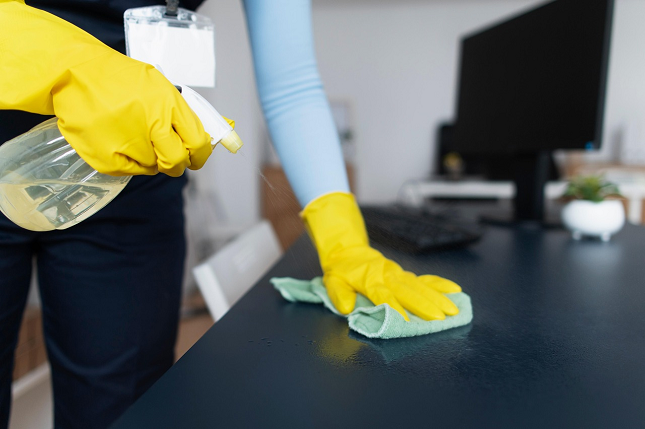Walk into any office on a Monday morning and you’ll notice the little things: the smell of fresh coffee, the hum of computers booting up, the shuffle of coworkers catching up after the weekend.
What you may not notice is the cleanliness of the space around you, but your body definitely does.
Think routine cleaning is just about spotless desks and streak-free windows? Think again. A well-kept workplace protects your team’s health, builds morale, and gives your business a performance edge.
As such, it’s one of the smartest investments most companies overlook. Let’s break down the specifics:
Sick Days: The Hidden Cost Lurking in the Dust
Every manager knows sick days are expensive, but few realize just how much.
According to one estimate, illness-related absences cost U.S. businesses about $3,900 per employee, per year when you add up lost productivity, replacement costs, and disruptions in workflow.
Think about that. If you have a 50-person office, simply keeping things clean could translate into hundreds of fewer sick days a year. That’s also less stress on the coworkers who usually pick up the slack when someone’s out.
The culprits aren’t always obvious. Research has shown that the average office desk harbors 400 times more bacteria than a toilet seat. Keyboards, door handles, and the breakroom fridge handle: these are hotspots for germs.
Without consistent cleaning, places like these become revolving doors for viruses and bacteria. This is especially true during flu season, which typically starts around October and peaks in December through February, per the CDC.
The Impact on Cleanliness and Morale
Here’s where it gets interesting: cleanliness affects how people feel about their jobs.
Imagine showing up to a cluttered, dusty workspace every morning. Even if you love your role, that environment wears you down.
Now picture walking into a spotless office where the air feels fresh, the carpets are vacuumed, and the breakroom isn’t a war zone of crumbs and coffee rings. It’s a completely different vibe.
Employees notice when leadership invests in cleanliness. It signals, “We care about your well-being.” That perception can make all the difference in how connected someone feels to their workplace.
In fact, clean spaces have been shown to reduce stress and improve people’s sense of accomplishment and satisfaction, according to Verywell Mind. Workers in well-maintained spaces are also more focused, less distracted, and even more creative.
This is real psychology. A tidy space reduces mental clutter, freeing up cognitive energy for actual work.
Productivity Gains: The Numbers Don’t Lie
Healthier employees + happier employees = more productive employees.
A study of non-profit organizations in the Netherlands found that measured cleanliness (things like surface dust levels and particle counts) was strongly linked to higher reported productivity and job satisfaction.
Air quality plays a huge role, too. Harvard T.H. Chan research has linked cleaner indoor air to improved decision-making and problem-solving. Poor air, on the other hand, contributes to fatigue, headaches, and sluggish thinking.
So yes, wiping down desks and vacuuming carpets may not feel glamorous, but in terms of ROI? It’s one of the smartest “investments” an employer can make.
How to Make Routine Cleaning Work for Your Workspace
What does a strong routine cleaning strategy look like? Here are some practical steps to implementing one in your workspace:
1) Daily Touch Points
These are the places everyone touches without thinking: elevator buttons, desks, water coolers, and breakroom appliances. A few quick wipe-downs each day can drastically cut down on germ transfer.
Think of it as your office’s daily line of defense. Even small actions can prevent bigger problems down the road.
2) Weekly Deep Dives
Once a week, it pays to go beyond the quick fixes. Vacuum and mop the floors to catch what daily cleaning misses, dust vents and light fixtures where allergens love to hide, and disinfect shared electronics like printers and copiers.
These are the spots that quietly collect grime and germs but don’t always make it onto the daily checklist.
3) Monthly or Quarterly “Reset”
Every few weeks or months, schedule a reset that refreshes the entire workspace. Shampoo carpets to remove deep-set dirt, clean upholstery to improve air quality, and replace HVAC filters so the air your team breathes is cleaner and healthier.
These deeper cleans not only protect employee well-being but also extend the lifespan of office assets.
4) Encourage Employee Buy-In
Routine cleaning works best when everyone contributes. Stock the office with disinfectant wipes and hand sanitizer, encourage “clean desk” habits so clutter doesn’t pile up, and post light-hearted reminders in common areas.
When cleanliness becomes part of the culture, it stops feeling like a chore and starts feeling like pride in your shared space.
5) Track Results
Measure the impact of cleaning! Keep tabs on absentee rates, gather employee feedback, and notice shifts in morale.
If sick days start dropping and satisfaction goes up, you’ll know your cleaning strategy is paying off in real, quantifiable ways.
The ROI of Routine Cleaning
At the end of the day, routine cleaning is all about outcomes. A cleaner office boosts morale and job satisfaction, helping reduce turnover and burnout, while also protecting long-term investments by extending the life of carpets, furniture, and other office assets.
In short, routine cleaning delivers the kind of hidden ROI most CFOs dream of finding.
Workplace Health Starts With Clean Habits & Practices
Too many companies treat cleaning as a “check the box” expense. The reality? Routine cleaning is a workplace strategy. It keeps people healthier, makes them happier, and allows them to do their best work.
The next time you’re reviewing budgets or wondering how to lift team morale, remember: the solution might not be a flashy new perk. It could be as simple as a disinfectant wipe, a vacuum, and a well-planned cleaning routine.
Better yet, bringing in professional cleaning services that can deliver consistent, high-quality results. This can turn routine chores into routine benefits.







































